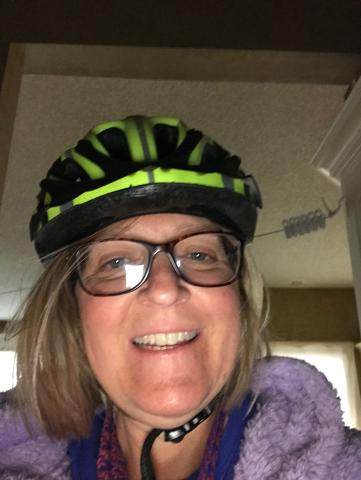Michelle knew what was wrong. She knew the headaches, regular vomiting, ear popping, and “whooshing” sounds in her head were all signs of leptomeningeal disease (LMD). The issue, however, is that LMD is so rare—only diagnosed in 5% of people with cancer—she had to advocate for the testing to prove it.
“I called my clinic and said I needed a brain MRI because I think I have LMD. They didn’t want to schedule one, so I said, tell my doctor I’m demanding a brain MRI. I can tell him directly if I need to,” says Michelle.
Leptomeningeal disease, or LMD, occurs when cancer from somewhere in the body spreads to the cerebrospinal fluid and leptomeninges that surround the brain and spinal cord.
The reason Michelle insisted she had LMD, even though they hadn’t tested for it yet, was because of a conversation she had been part of many years earlier. She was first diagnosed with ALK+ lung cancer in 2018 and started attending LUNGevity meetups when they went virtual during COVID. One of her friends in the meetup group talked about regular and persistent headaches that were a symptom of developing LMD. This friend passed away shortly after, creating a moment that Michelle would never forget—and that would eventually save her life.
Michelle knew LMD advanced quickly, and when she arrived for her brain MRI, she stayed firm in demanding immediate answers. She wanted the radiologist in the room to read the scan as it came through. The staff said it wasn’t standard procedure, but Michelle again told them she needed the radiologist in the room.
“I became a person I didn’t know. I was saying the words but didn’t feel like myself. You really have to get out of your comfort zone if you want to live.”
The scan showed swelling, and Michelle was admitted to the hospital for further testing. The next day, she underwent a lumbar puncture (spinal tap) which found cancer cells but no evidence of LMD. One day later, undergoing yet another brain MRI, they finally confirmed what Michelle already knew—she had LMD.
“In a three-day span I went from having no detectable disease, to having mild disease, and then moderate disease,” says Michelle.
Is There Even a Treatment Plan?
Her doctor delivered the news as a death sentence. They didn’t know how long she would live given LMD's nature as a fast-progressing disease that often comes with a prognosis of months if not weeks. The only direction she was given was to get her affairs in order.

“Out of nowhere—I still don’t know how they found me—two young and happy-looking people walked into my hospital room. They said they had a treatment for me,” says Michelle.
First, they told her to meet with a neuro-oncologist and LMD expert. Michelle's next few months—from late 2023 to early 2024— would be decided by the expert these two strangers recommended.
When I met my LMD specialist, Dr. Adrienne Boire, I knew she was the right person. She started asking me questions that nobody else had. She knew what I was going through.
Michelle was deemed a good candidate for a combination of targeted therapy and proton craniospinal irradiation (pCSI) whole-brain radiation. The underlying ALK+ mutation, catching her LMD early, and her commitment to staying active and remaining as healthy as possible despite her cancer history were all factors in this decision.
The treatment was a major success, and she reached a point where there was no detectable LMD left.
Creating a Recovery Plan from Scratch
Despite the good news, Michelle entered unknown territory once again. So few people catch and successfully treat LMD that there wasn't a standard rehab plan she could follow. All she knew was that over the next few months she could expect to feel the effects of what her doctors called the “messy mix.”
“They told me I would just have to wait it out. The combination of pCSI, medication, and disease causes a lot of pain. I ended up with no pain and minimal side effects, but still needed to create my own recovery plan,” says Michelle.
Post treatment, Michelle experienced:
- Hair loss
- Trouble walking
- Loss of hand-eye coordination
In response, Michelle created her own rehabilitation plan that included:
- Latch-hook crafting to work on hand-eye coordination
- Puzzles to keep her mind active
- Reading to help retrain her eyes to move from left to right
- Physical therapy that helped her progress from not walking, to using a cane, and now walking freely

It’s been almost a year and a half since Michelle finished treatment for her LMD. The side effects have passed, and her rehab continues. She’s approaching the point where driving might be an option.
"I'm where I am today because I found the right people, in the right place, at the right time. It's a mistake to not have a team of specialists. In addition to a neuro-oncologist for my LMD, I also have a psychologist, ocular oncologist, dental oncologist, palliative care expert, thoracic oncologist, radiation oncologist, and my primary care provider. You really need a full team," says Michelle.

